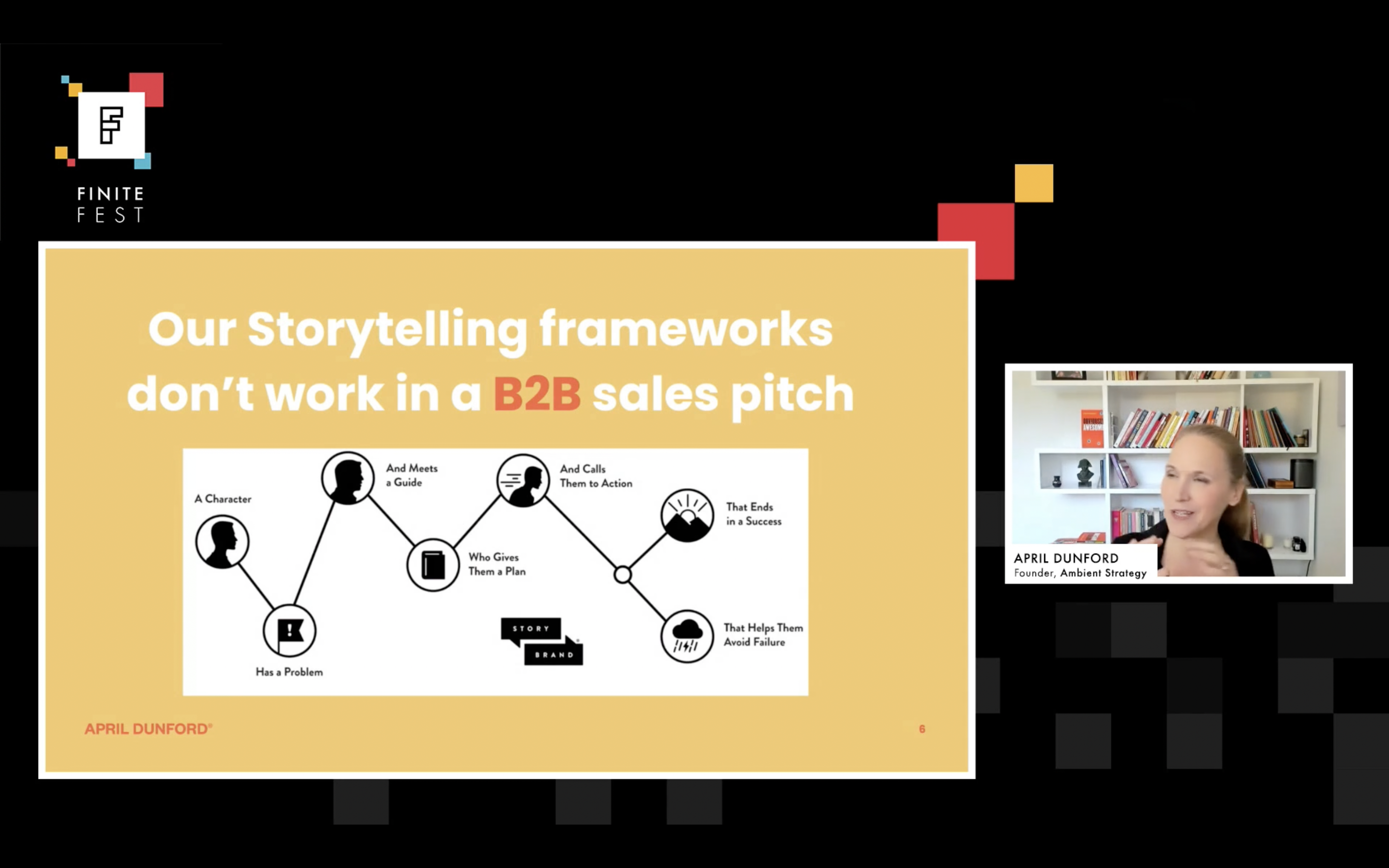April Dunford on crafting stories for sales enablement in B2B tech marketing
At FINITE Fest, April Dunford’s presentation taught B2B tech marketers sales enablement through the crafting of stories to tell prospects an engaging narrative. As marketers, we are natural storytellers who can provide B2B sales teams with the context they need to encourage a conversion.
April Dunford on what customers want from a B2B sales experience
To hear more about sales enablement from April Dunford, FINITE members have access to the full session – Apply here for a free membership and join B2B tech marketers around the world to expand your career.
FINITE Fest, the free one day virtual conference covering B2B tech marketing trends, was proudly supported by 93x.
Here are the key takeaways:
- What does storytelling look like in B2B tech marketing vs. B2B tech sales?
- What does a B2B tech buyer want from a salesperson?
- Tackling no decisions in B2B tech marketing
- Components of a good sales narrative
- Positioning to find a sales narrative
What does storytelling look like in B2B tech marketing vs. B2B tech sales?
As marketers, we use storytelling in many different ways. We see stories in case studies, company origins, brands, visions, missions and values. We weave stories into every aspect of marketing with one big purpose in mind – to generate leads for a B2B sales team.
Conversely, typical B2B sales calls do not involve many stories. Instead they spout about the numerous features a product can offer a prospect. The sales call won’t have much of a narrative structure. Instead it will involve an attempt at persuasion through a demo or a list of incentives.
“Most of the companies I work with, if I listen in on a sales call, the experience for the customer is a bit like they’re walking in and standing in the wind tunnel of words relating to features.” – April Dunford
The typical B2B sales story follows a classical hero structure. The hero is the prospect, they have a challenge they need to overcome, they have a helpful sidekick (a sales rep) and they reach a happy ending as a happy customer.

However, this classic hero structure doesn’t actually work well in B2B. The landscape is too competitive and a happy ending is not what a prospective customer wants to learn about.
What does a B2B tech buyer want from a salesperson?
Often in B2B, the person who is trying to purchase a solution has never purchased this solution before. Their first step in the buying journey is to create a shortlist of companies that offer the solution they need.
When they start Googling potential solutions, they end up on software advice publications and research papers that showcase thousands of companies. All of these companies look the same to the buyer. How can they differentiate them all?

“B2B software customers, what do they want in a sales experience?… They want a sales person that can help them navigate alternatives.”
The prospect needs to make sense of their options. They don’t want to know about features or the company itself, they want to learn about the marketplace and your company in the context of your competitors.
You need to educate a prospect on what they need to solve their challenges, what to avoid with competing companies and what outcomes they should be looking for. To start their buyers journey, they need help from a sales rep to figure out who to shortlist.
In B2B tech, solutions are competitive. In giving context of the marketplace, you can tell a prospect what you can provide that the other competitors can’t.
Listen to or read about this podcast to learn more about sales enablement.
Tackling no decisions in B2B tech marketing
“Four out of ten purchase processes end with no decision.”
Buying teams make no decisions because they cannot agree on an approach. To tackle this, they need insight into the market.
IBM has highly structured product narratives because their products are mature and their markets are mature where differentiators are small. E.g. their database system competitor is Oracle and 99% of the product features are the same. How does a sales rep make a case for the same product?
The sales reps should explain the 1% difference by weaving a story around approaches to the customer’s problem. IBM customers cared about flexibility and innovation, so their 1% differentiation suits this value. After describing alternative solutions, an IBM sales rep should explain how this 1% will benefit the customer far better than the alternatives.
Components of a good sales narrative

This framework gives the customer a way to think about the market. The majority of the story should be about market insight, with a bit about your company’s value – not features!
Positioning to find a sales narrative
“Each step of this sales narrative conveniently matches to a component of your positioning.”
You can’t create an effective sales narrative without positioning your product first.
- Start with defining your competitors. Look at the market and understand it deeply.
- Figure out which features and functionalities you can offer above your competitors.
- With differentiating features, you can associate these with a unique value to offer customers.
- Next, you need to find which customers care about the extra value that you offer. These will be your best fit customers.
- Finally, find the market that makes your unique value available and obvious to these best fit customers.
Hear more insights from April Dunford by listening to this episode of the FINITE Podcast on positioning for B2B tech companies.
